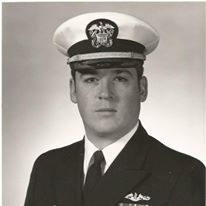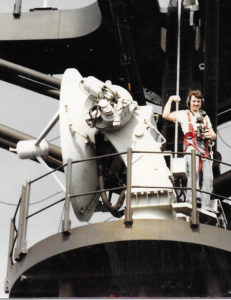When Steve Hart went through Marine Corps boot camp, like so many recruits, he vividly remembers the stinging experience of having to endure exposure to tear gas without any protective gear to protect his eyes or help him breathe.
“I didn’t like that at all,” Hart recalls matter-of-factly.
So, what did he do? Hart, who now works for the UW–Madison Division of Information Technology (DoIT) as an assistant director in Enterprise Business Systems, immediately called to mind the very first of the 11 Marine Corps leadership principles he’d learned: “Know yourself and seek self-improvement.”
“I thought, ‘What am I afraid of? What are my fears?’ And so I signed up for nuclear, biological and chemical training, where I’d have to be in a room like that without a gas mask all the time,” Hart explains. “And so the next time I was in that room, leading Marines, I wasn’t struggling for air or showing a sign of weakness. I was leading by example.”
It’s this kind of “adapt and overcome” mindset that Hart and other military veterans say helped them not only in their years of service, but also many years later, as we all now cope with the uncertainty of living and working in a pandemic.
In a DoIT-led panel discussion in August, several former members of U.S. military branches gathered to discuss the concept of resilience, and how their military training has helped them build resilience in the face of adversity and challenges. The panel was assembled to share insights and advice with DoIT colleagues who do not have military backgrounds.
Building resilience: Read part 2 of the resilience series, with personal advice from our military panel members to help you build your personal and team resilience. And check out some resources and tips.
What is resilience?
Pandemic life has arguably thrown us all into a near-constant state of disruption and adjustment, as we grapple with upheavals in both our personal and professional lives. In many ways, big and small, life is just different now. And it’s our capacity to adapt to those differences that defines and builds our resiliency.
So, what does it mean to be “resilient?” It’s not necessarily a personality trait that only some people have. On the contrary, according to the American Psychological Association, resilience involves behaviors, thoughts and actions that anyone can learn and develop.
The concept of learning resilience—and training to get better at it—is embraced within the military, from boot camp to returning home from a deployment. In a 2011 study for the Department of Defense, the concept of resilience in the military was explored at length, putting forth the following definition:
Psychological resilience is defined as the capacity to adapt successfully in the presence of risk and adversity. It refers to the process of coping with or overcoming exposure to adversity or stress. It’s more than an individual personality trait—it is a process involving interaction among an individual, that person’s life experiences, and current life context.
Members of DoIT’s “Resilience in Adversity” panel agreed that building resilience is a process that must be practiced.
30-year active duty Navy veteran Katherine Mayer used the example of coming off a deployment, noting the extensive reintegration measures taken to reorient a sailor to civilian life.
“They actually bring a team of psychologists and every expertise under the sun you can imagine in order to go through training, to go through scenario practice, to do role-playing,” says Mayer, who currently works as associate vice president for information security at UW System.
“It’s a long time across the Atlantic before you hit Norfolk, or wherever you’re going—so there’s a lot of time to do that sort of training,” Mayer added. “Resilience is practiced, and I 100% agree that it’s a process.”
Resilience & mission focus
Another critical success factor in the process of building resilience is knowing the mission of your team or organization, as well as feeling confident that your leadership is looking out for you, panel members said.

Recalling his 23 years in the Navy, Chief Information Security Officer Bob Turner stressed that good leadership at the unit level is key, whether you’re climbing into a submarine or ramping up for a new academic year working for DoIT.
“One of the things that’s paramount is the concept that ‘Troops eat first,’” Turner explains. “We make sure that we take care of our people, and we make sure that everything we do is to support them—because I know that as a leader, I need to depend upon every member of the unit to be ready to go.”
“That directly traces to the experiences that we’ve had here in DoIT,” Turner added. “The leadership is on target in making sure that everybody understands what’s going on, and that there’s always clarity. In the Navy, we had the ‘Plan of the Day,’ and we had the mission orders. Here, we have the same level of openness and keeping everyone in the loop as things are evolving. That’s a success factor—people who know what to do will automatically do that, knowing that they’re sharing that common mission and that common leadership influence.”
Training To Build Resilience
In addition to knowing and focusing on the mission, several other panel members echoed the importance of training to build resilience—learning as much as you can in your area in order to be nimble and fill any voids you see.
“I think it’s important for each team member to know how their specific missions contribute to the overall objective. Then, how each teams’ missions fit together, which allows us to see the gaps,” said Mike Vavrus, a DoIT cloud engineer with 14 years of service in the Navy and Army. “Communication of the overall objective is critical, from the top to the bottom of the organization.”
“Confidence is key,” Vavrus added. “Once you’ve trained up and you understand the basics and you know what the mission is, that gives you a lot of freedom to make decisions when things get stressful.”

For Navy veteran Don Ussery, the process of putting out literal fires in boot camp helped him build confidence, which later allowed him to take on duties he never imagined he’d be capable of.
“I got put on a destroyer, of all things,” recalls Ussery, who now works for DoIT as assistant director for the Enterprise Resource Planning admin team. “Here I am, operating a multimillion-dollar weapons system, and I’m a 20-year-old wet-behind-the-ears kid. Yes, a lot of those days were uncomfortable—riding a destroyer in the middle of a typhoon is not a pleasant thing to do—but I had a job to do on that ship, and I did it. You embrace the pain of evolution.”
“I gained trust in those people on the ship, they gained trust in me, and we became a unit because we did our jobs and we did it together to fulfill the mission of the ship,” Ussery added.
Maintaining a sense of humor with your colleagues can also help you through the “pain of evolution,” whether you’re in the military or building an administrative transformation for the university, says Jim Martin, an Air Force veteran who joined the ATP team last year as senior project manager.
“In the face of adversity—in the middle of combat or just hard times—we can all joke around a little bit once in a while,” Martin said. “It’s all part of sharing a common experience.”

And in the midst of what can feel like the constant doom and gloom of a pandemic, 28-year Army and Army Reserve veteran Tim Bohn urges his colleagues to do as he learned in Army Reserve Master Resilience Training: “Hunt the good stuff.”
“I don’t focus on the bad. I focus on the good, so it doesn’t send me or my team down, spiraling,” explains Bohn, assistant director of common systems cybersecurity. “If you look at the good stuff, that always brings people up—whether that’s in my deployment, or here at the university as a leader. Think, ‘what good came out of today?’ That helps me, and maybe it will help some other people, too.”
Part 2: Resilience Tips & Tools
Next in the series: Read the personal advice from our military panel members to help you build your personal and team resilience, and check out some resources and tips that will help you practice some core components of resilience.
